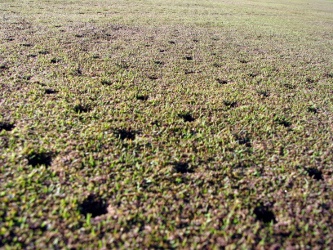
In golf, the term aeration refers to a maintenance practice performed on golf course greens, fairways, and tee boxes to improve turf health and playing conditions. Aeration involves the removal of small plugs or cores of soil from the ground, which helps alleviate compaction, improve drainage, and promote healthy root growth.
Here are some key points about aeration in golf:
- Purpose: Aeration is primarily done to enhance the health and quality of the turf. Golf courses receive significant foot traffic, which can cause the soil to become compacted over time. Compacted soil limits the flow of air, water, and nutrients to the grass roots, resulting in poor turf quality. Aeration helps loosen the soil, creating space for roots to grow deeper and access essential resources.
- Process: Aeration is typically carried out using specialized equipment called aerators. There are different types of aerators, including core aerators, spike aerators, and slicing aerators. Core aerators are most commonly used in golf course maintenance. They remove small plugs of soil from the ground, creating holes in the turf. These holes allow air, water, and nutrients to penetrate the soil and reach the roots.
- Timing: Golf course aeration is usually scheduled during specific times of the year when it will cause the least disruption to play and allow the turf to recover quickly. The timing may vary depending on the climate, grass type, and golf course management practices. Aeration is commonly performed in the spring and fall when the grass is actively growing.
- Impact on Play: Immediately after aeration, the golf course may have visible holes or plugs on the surface, which can affect the smoothness of the greens and fairways. Golfers may experience slower putting speeds and uneven ball bounces until the turf recovers. However, the long-term benefits of aeration outweigh the temporary inconveniences, as it helps maintain healthy and playable turf conditions.
- Post-Aeration Care: Golf course maintenance teams follow specific post-aeration practices to aid turf recovery. These may include topdressing with sand or other materials, rolling the greens, and providing adequate irrigation and fertilization. These measures help smooth out the playing surface, fill the holes left by aeration, and encourage turf growth.
Aeration is an essential maintenance practice in golf course management, ensuring the long-term health and playability of the turf. By improving soil conditions and promoting healthy root growth, aeration contributes to maintaining optimal playing conditions for golfers.
A golf course maintenance practice in which small holes are punched into greens (and sometimes fairways) to oxygenate the grass’s roots and loosen compacted soil. Most courses aerate their greens once or twice per year to keep them healthy.





